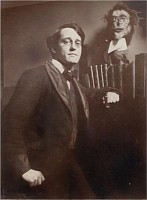BIOGRAPHY

1871-1951
John Sloan studied at the Pennsylvania Academy of Fine Arts, Philadelphia, from 1892 to 1894. He sold his first canvas at the age of 14. He regularly worked as an illustrator for newspapers such as the Philadelphia Inquirer and the Philadelphia Press, but he also designed advertising and taught himself the technique of engraving. On the advice of Robert Henri, he moved to New York in 1904 and subsequently became a member of The Eight. Sloan was politically active and joined the Socialist Party in 1910; he stood for election to the New York State Assembly the same year but was defeated and stood again in 1915. He trained at the Art Students League in New York in 1916 and was elected president in 1931 but resigned the following year to join the Archipenko School of Art. He joined the League again in 1935. In 1929, he was elected to the National Institute of Arts and Letters. His teaching has influenced a whole generation of artists.
John Sloan’s first paintings were portraits, dating from 1896–1897. Robert Henri, considered to be the leader of a new generation of painters, had a great influence on him. Sloan intended to take up Eakins’ Realist tradition and relate art to contemporary life; his paintings—like his engravings, of which he was one of the main exponents of his time—portray realistically the sometimes wretched aspects of daily life. When in 1907 the National Academy of Design refused to show his works, or those of other painters such as Luks and Glackens, Robert Henri, who was a member of the Academy at the time, withdrew his own works in protest. The following year, these same artists together with a few others exhibited together in the only exhibition held by this group, which became known as The Eight, and which was derisively nicknamed the Ashcan School by New York art critics. Besides Robert Henri, William J. Glackens, George Luks, and John Sloan, the members were Everett Shinn, Arthur B. Davies, Ernest Lawson, and Maurice Prendergast. The Eight was a very diverse group, but Sloan specialised in pictures of street life. In Election Night in the Herald Square (1907), the muted shades and visible strokes depict the crowd and its movement. The same is true of Fifth Avenue(1909). Woman’s Work (1911) is typical of the subjects taken from everyday life: a woman laying out washing on a windy day. Sunday, Girls Drying Their Hair (1912) is in the same vein, young girls drying their long hair in the open air on the roof of a building. This picture was shown at the Armory Show in 1913. In 1914, Sloan settled in a popular district of Manhattan, where he observed and sketched his neighbours.
John Sloan’s paintings and engravings rejected conventional subjects and the conformism prevailing at the turn of the 20th century, and instead ‘democratised’ painting by giving expression to the vitality of real-life everyday occupations. His Realism is nevertheless a reflection on painting itself, as suggested by the modern advances, that he was aware of and participated in, at the 1913 Armory Show in New York.
From 1905 onward Sloan received many awards, including a bronze medal for engraving at the San Francisco Pan-Pacific Exposition in 1915; a gold medal for engraving in 1926; a gold medal for painting awarded by the Pennsylvania Academy of Fine Arts in Philadelphia in 1931; and another in 1950 from the Academy of Arts and Letters.
